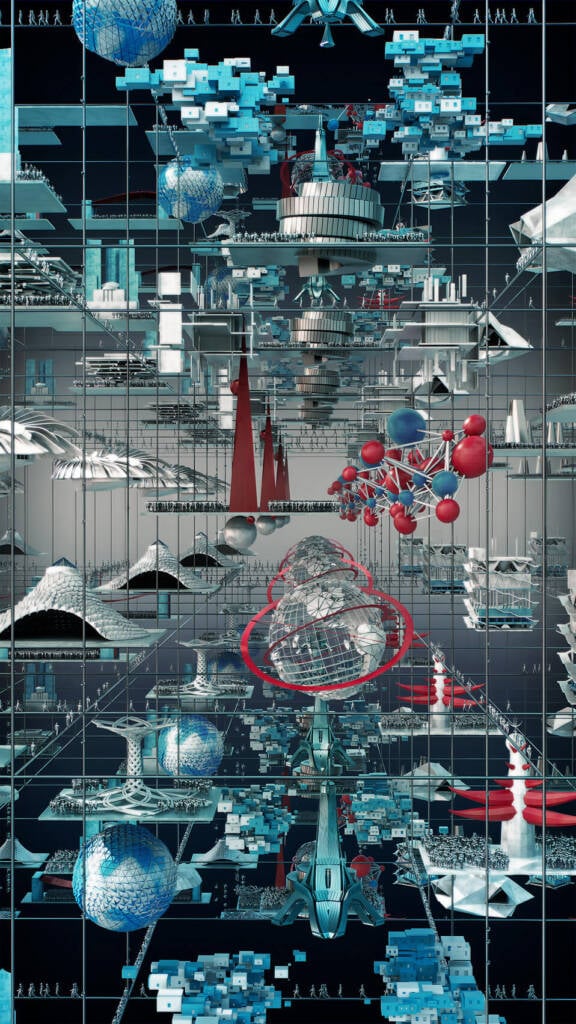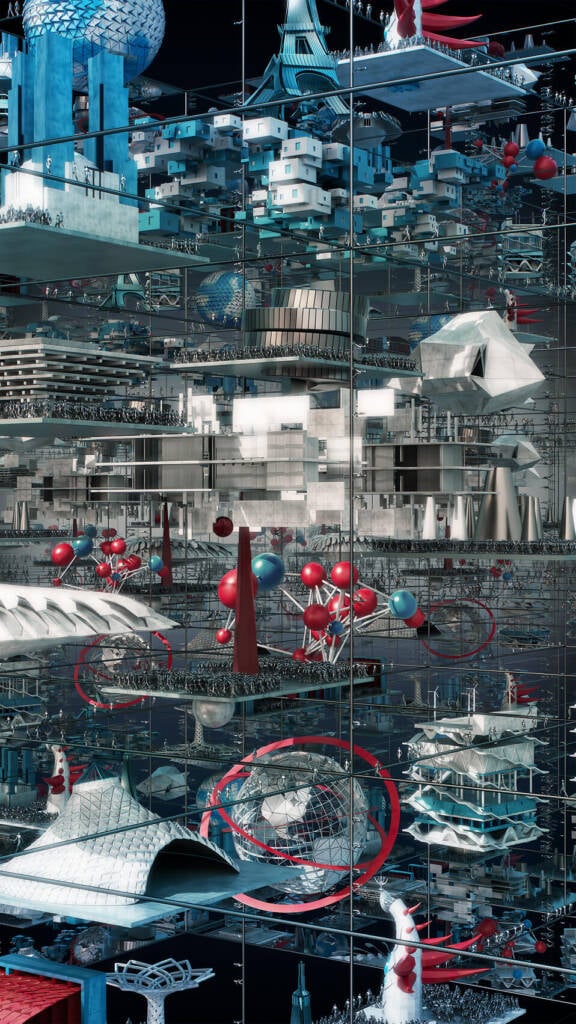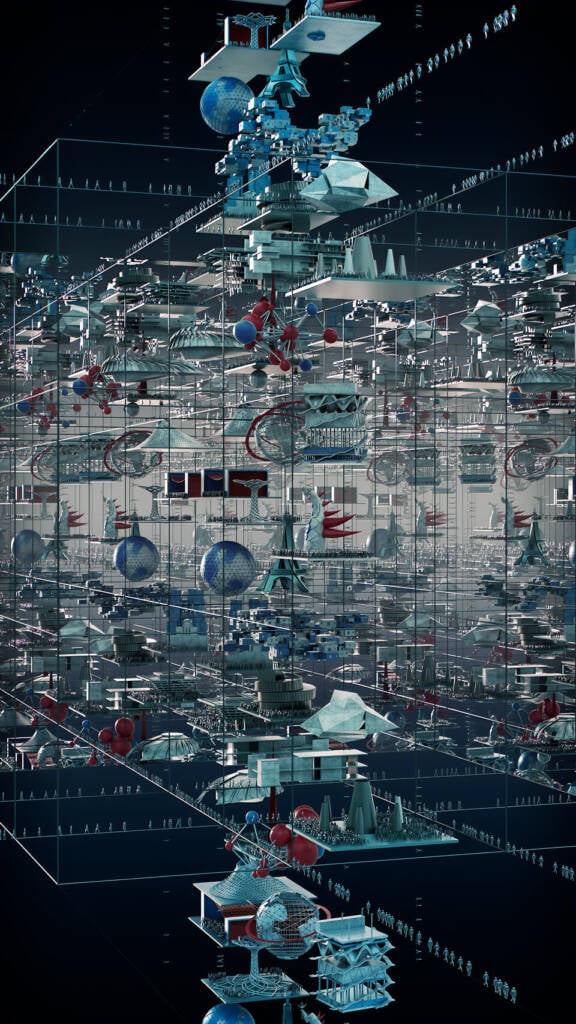After directing the feature film Demolition Man, artist and filmmaker Marco Brambilla developed a body of work exploring media and collective imagery through large-scale video installations—often using contemporary technology to evoke nostalgic visions of retrofuturism and to experiment with ai-assisted art. His Megaplex series—among others—has been exhibited internationally in museums, and his work is held in the collections of the Museum of Modern Art in New York and the Solomon R. Guggenheim Museum.
In 2024, Brambilla debuted the digital moving-image series Approximating Utopia across 95 billboards in Times Square, New York. His upcoming exhibition After Utopia, opening on the 2nd of December 2025 at The Wolfsonian–Florida International University in Miami and running until the first of March 2026, continues this conversation using artificial intelligence-assisted research and computer-generated imagery to construct virtual landscapes inspired by world’s fairs spanning three centuries. Animated from archival imagery of iconic structures, the work is presented in tandem with the museum’s exhibition World’s Fairs: Visions of Tomorrow, connecting past suppositions of progress to contemporary forms of technological spectacle.
hube: The exhibition is titled After Utopia. What drew you to this title, and what conceptual or emotional terrain does it open up within the broader arc of your practice?
Marco Brambilla: After Utopia is a title I came up with because we had the idea of using AI to create, or at least inform, a work that would also comment on the way AI is becoming a part of our world. Back in the sixties and seventies, there were all these architects who inspired me when I was younger—Archigram and Superstudio from Italy. Their work was always driven by a concern for a better life for people, a utopian condition, which was usually conceived physically. All their designs were meant to be realized in the physical world.
This led me to think about World Expos, and the idea that they have always embodied hope for mankind through technology. I’ve always been fascinated by World Expos. I visited maybe six or seven sites after they were decommissioned—Saka, Shanghai, Seville, Montreal, and Brussels. I’ve always been captivated by these arcs of civilization. They were like time capsules, preserving the spirit of their era. Every Expo introduced some new technology: in New York, 1964, a 360-degree movie theater for Kodak; in Osaka, a film screen that projected images on water mist; in Montreal, the monorail; in Dubai, 2020, the focus was on sustainability. Each Expo demonstrated the idea that technology—whether in engineering, electronics, or biotechnology—could improve human life and promote harmony with the environment.
If you were to imagine a utopia today, it would likely exist virtually rather than physically. A few years ago, there was a lot of discussion about the metaverse and digital environments where like-minded people could meet in infinite, reconfigurable spaces. I began this project when the first AI image generator was introduced and realized I could combine a technology that has the potential to both limit and expand our imagination. AI can enhance our ability to dream, enabling us to conceive ideas larger and more fantastical than what an individual could imagine alone. At the same time, it introduces an element of unpredictability—a shift in directions we may not fully control.
This dichotomy between technology and the spirit of utopia—the vision of cities that allow us to live in harmony with technology—is what truly fascinated me. I decided to create the work and selected 18 Expos to focus on. We trained the AI with extensive imagery and a wide range of data: national anthems, Expo statistics, attendance figures, and more. Then AI helped determine which pavilion to feature—the one that was most searched for or most celebrated in each case.
h: Could you walk us through your research process—particularly how you collected, analyzed, and reimagined historical material from the original pavilions while developing these moving-image works? What questions or themes guided your inquiry?
MB: I began working with the Wolfsonian Museum, where the piece will be shown for the first time, about two years ago. They hold the largest archives of physical blueprints, brochures, floor plans, and sculptures of pavilions up until 1970—everything pre-internet that was otherwise difficult to find for training AI models. My team and I visited the museum and were able to scan 3D models, images, blueprints, and various artworks, and then input the corresponding metrics. This became the foundation of the library.
For the more recent Expos, most of the research was done online, so the library was supplemented with digital archives. From this comprehensive collection, I began selecting the elements I wanted to feature and bring to the foreground. I was inspired by the idea of migration—people moving from one future to another—because each Expo had a specific chronology and geography. The lines of people you see in the final work are algorithmically generated: they correspond to the actual number of visitors to each pavilion that year, yet they also move across the conceptual grid that structures the piece.
AI was used from the very beginning for sketching and experimentation. I was particularly drawn to the idea of dynamic architecture, reminiscent of Archigram. One concept I especially loved growing up was the Plug-In City—a city that could move to the suburbs or countryside, bringing culture with it: movie theaters, book readings, circuses—a fully mobile cultural hub. AI allowed us to animate the buildings according to the movement of people, creating unexpected and surreal simulations that made each Expo come alive.
The research phase involved extensive training and input—perhaps too much at times—followed by a careful selection of the information most relevant to the final vision of a future utopia. That vision is what After Utopia represents: distilling all these time capsules into one hopeful future, just beyond reach, just over the time horizon. That was the core idea behind the work.

Photography by KOEN BROOS

After-Utopia
Courtesy of MARCO BRAMBILLA

After-Utopia
Courtesy of MARCO BRAMBILLA

After-Utopia
Courtesy of MARCO BRAMBILLA

After-Utopia
Courtesy of MARCO BRAMBILLA
h: What role do people play in the World’s Fair? What made you decide to include them? On the surface, most people think of the architecture or the art, but you’re also emphasizing the spectators. Why was that important to you?
MB: Each World Fair attracted a different and shifting demographic of visitors. I think the human component was actually very important, as it underscores the way the work is presented: we are essentially erasing both chronology and geography. Yet the people remain constant. They are always migrating from place to place, even as all these spaces exist in a “non-world” where time and geography no longer apply.
That said, it’s important to note that once all the research was completed, I completely stopped using AI. The final work was created entirely using computer graphics. All of the research and animations informed the creation of the piece, which draws inspiration from Superstudio. The animations were then integrated into the computer graphics workflow typically used in films. While all the moving buildings, platforms, and people are algorithmically generated, the architecture itself is carefully directed and meticulously placed according to the system sketched in AI.
To achieve the resolution required for display—a very high-resolution, large-scale canvas—we employed a hybrid technique, combining the AI-informed planning with advanced computer graphics rendering.
h: AI remains a relatively new creative medium with few established visual or conceptual precedence. Yet your work often evokes a mood of nostalgic, retrofuturism. How have you navigated the constraints and possibilities of this emerging technology, and how has it expanded or altered your artistic language?
MB: The retrofuturism is very interesting because all the utopian architects I just referred to were from exactly that era. It was a time when people imagined driving cars to the moon—the sixties and seventies. The future they envisioned for us today was much more utopian than the one we actually inhabit.
The process of making the work was a dialogue between me and the people I was collaborating with, who specialize in AI. That back-and-forth is also part of the concept of the work. The concept explores how much agency we have over our own future: if we choose to adopt systems that tell us what movies to watch, where to eat, who to speak to, and what will feed us, what does that mean for our autonomy?
During the process, an unexpected realization emerged: I couldn’t really direct AI toward a very specific vision. I ended up using it mainly for research and training, before returning to a more handcrafted approach. While the work exists digitally, authorship remains firmly with the artist. The final piece is created in a format authored by me, not by AI. I find AI-generated work to be, by definition, retrospective—it can only learn from what has come before. But when creating a future utopia, you need to move beyond AI. You use it, take advantage of what it offers, and then move forward to create a snapshot of a future that doesn’t yet exist—informed by AI, but not made with it.
AI is a tool, and understandably, people are often enthusiastic about new tools. When a new technology appears, it’s easy to assume, “Oh, it’s so simple to generate this now.” But even the sketch I made for Times Square, which used very primitive AI, taught me that the museum show would require a completely different approach. I hadn’t anticipated how challenging it would be to get AI to produce something very specific. That dialogue — between myself and the tools — has been an invaluable experience, helping me understand how to use AI effectively: as a research and sketching tool, not as a way to produce the final work.
h:Your work frequently explores the aesthetics of excess—a sensibility that echoes the World’s Fair, where entire architectural universes were built and dismantled. In your view, can the World’s Fair meaningfully respond to contemporary demands for sustainability, and should the idea of the Fair itself evolve to meet the ecological realities of the 21st century?
MB: I think it has. For instance, in Seville, the Expo has been repurposed into an office complex; in Montreal, it’s become a park. The World’s Fairs are now being metabolised into a sustainable system. The theme in Dubai was, in part, sustainability. They are being designed with that in mind now, where the structures themselves can be repurposed and used. In Montreal, in 1960, this was a precursor to the conversations that are going on today. Habitat, which was Moshe Safdie’s first futuristic modular housing, was low-income housing for people that became an apartment building right after. The Olympic Village became student housing. A lot of these events, like the Olympics and World’s Fairs, definitely have an intention now to keep them alive for a different purpose so that they’re sustainable.
h: Your Italian-Canadian background bridges the ‘Old World,’ with its layers of historical memory, and the ‘New World,’ shaped by modernity and reinvention. How does this dual heritage influence your perception of time—past, future, and the unstable space where they converge in your practice?
MB: I’ve always felt dislocated. Growing up in Italy and then moving with my family to Canada, I was always an outsider in both places. This idea of a “non-world” has been central to my work. My first book, Transit, was about airports; I photographed airports extensively, and much of my work continues to explore them. I also filmed a piece called Approach, now in the Corcoran collection. Another work, Revolving Rest, explored the idea of non-geographical revolving restaurants: we took nine revolving restaurants across North America and combined them into one time zone, so the sun would rise simultaneously.
Being everywhere and nowhere, psychologically, is a recurring theme in my work. It is particularly prominent in this piece. When I first arrived in Montreal, one of the first places my father took me was Expo 67. For me, the contrast between the old world of Milan—its historic buildings—and Montreal with Buckminster Fuller’s dome and the monorails left a profound impression. This sense of dislocation and existing in transitional spaces has informed many of my previous works.
The process has always informed the work. I’ve been developing this piece for two years, and throughout that time, the process itself guided me toward what I wanted to express. There is a certain detachment in the work: you are observing these time capsules in a non-space. They appear beautiful, almost like the Emerald City, but you are outside, looking in.
Montreal was envisioned as the future capital of Canada. Its mayor wanted to compete with France, even planning to bring the Eiffel Tower to Montreal for the Olympics, disassemble it, and later return it. This real, built environment—a new outpost of Futurism—is captured in the piece. That sense of wonder and ambition deeply informed the work.
This project has been on my mind for a decade, but it was only when I realized I could use AI to inform its creation that the concept fully took shape. What interested me most was the condition it represented: a two-year journey exploring multiple iterations of the work. I also drew inspiration from Karl Marx’s concept of the General Intellect (1857), a communal form of knowledge. AI, in a way, represents our version of shared intellect today—accessible, collective, and utopian.
I am very grateful to have collaborated with the Wolfsonian Museum, which houses the archives that made this work possible. From the very beginning to its first exhibition, the project has come full circle.
h: The World’s Fair has long served as a symbol of collective aspiration, spectacle, and technological optimism. What associations or resonances does it hold for you personally, and how do you think it shapes our shared cultural intellect and memory today?
MB: It is a mode of general intellect where you’re inviting people from all over the world to be inspired or motivated. There’s a great story about Walt Disney’s father working on the World’s Fair in Chicago when they built the White City. Walt Disney’s father was one of the contractors working, building this White City. It was built in Chicago for 1939. And then he went back, and he created Disneyland and Epcot. He was inspired by this collective dream. This physical collective dream goes from Paris right through to Osaka now. It covers that span of time, and it also looks at the way the fairs have changed and the way the structures have become more futuristic and the spirit aligns.
There’s always been a motto for each Expo: Montreal was Man and His World. Shanghai was Better City, Better Life. There was always a slogan. The idea of getting to sample all these touchpoints, and the physical aspect of it, is irreplaceable. When people can gather somewhere and have conversations, go to lectures, I think people come away hopefully being inspired because it still puts the best forward; it still puts the utopian vision of the world forward, as opposed to the dystopian vision of the world.
h: Utopia is a recurring motif in your work—a way of imagining the future through the fragmented realities of the present. In After Utopia, you revisit the legacy of the World’s Fair through AI assisted research. How do you understand the notion of “the future” in this context, and in what ways does it align with or depart from your own vision of utopia?
MB: The concept was a question of which direction we’re moving—because of the influence of technology in our lives, in everything, and the invisible technology, the invisibility of technology today, where we don’t even notice it, but we interact technologically with other people, with technology. I think that forms behaviours that may subconsciously lead us in different directions. That’s one of the contradictions that this work presents. It presents, ‘Now that this is all virtual, do we understand it? Can we process it? Where’s it going? How is it made?’ And then we may become passengers to our own future. Our futures may be generated autonomously in five years. We don’t know. But the theme is a larger theme. If you were to think, okay, Expos are collective dreams at that point in time—now let’s take these collective dreams, feed them into a machine, and then let’s see what it postulates for our collective dreams in the future. And that’s actually what may happen—not because of Expos, but Expos were just a very clear, very pure example of human aspiration. I wanted to take that and see what’s going to happen to human aspiration when we’re constantly talking to machines. Are the machines going to generate our dreams at some point?

After-Utopia
Courtesy of MARCO BRAMBILLA

After-Utopia
Courtesy of MARCO BRAMBILLA
Words: ISABELLA MICELI

